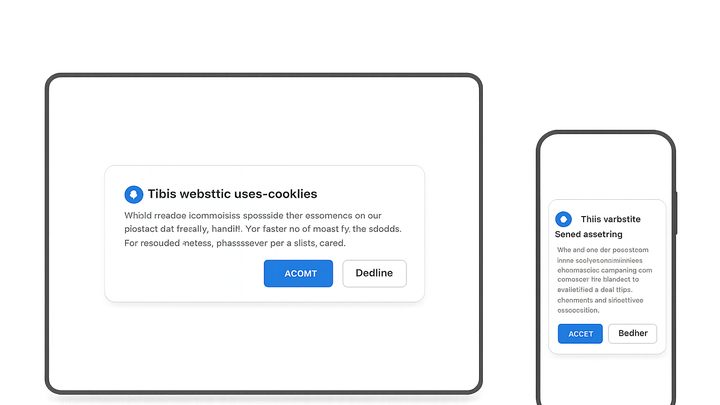Published on 2025-06-29T21:37:34Z
What is Cookie Consent? Examples for Cookie Consent
Cookie Consent refers to the mechanism by which websites request and obtain permission from visitors to store cookies on their devices. Cookies are small data files used for various purposes such as tracking user behavior, storing preferences, and enabling personalized experiences. Compliance with privacy regulations like GDPR and CCPA mandates clear and explicit consent for non-essential cookies. Properly implemented cookie consent banners not only ensure legal compliance but also build trust, enhancing user experience and conversion rates. The design, timing, and language of the consent prompt can significantly impact user engagement, making it vital to balance transparency with minimal friction. Tools like Prevue.me can audit your consent implementation and provide actionable critiques for optimizing CRO, UX, SEO, and accessibility.
Cookie consent
Cookie Consent: user permission for cookies, ensuring compliance, trust, and optimized UX/CRO/SEO via clear, accessible opt-in banners.
Overview of Cookie Consent
This section introduces what cookie consent is, its role in legal compliance, user trust, and its basic mechanics on websites.
-
Definition and purpose
Cookie consent is the process of gaining user approval before placing non-essential cookies. It ensures transparency and helps meet regulatory requirements.
-
Types of cookies
Cookies are categorized by function. Each category may require distinct consent handling under different regulations.
- Necessary cookies:
Essential for website functionality; typically exempt from consent requirements.
- Analytics cookies:
Track user behavior to inform improvements; require explicit opt-in.
- Marketing cookies:
Enable targeted advertising and personalization; need clear user permission.
- Preferences cookies:
Store user settings such as language or theme; often require consent depending on jurisdiction.
- Necessary cookies:
Impact on UX and CRO
Cookie consent banners can improve transparency but also introduce friction that affects user engagement and conversion metrics.
-
Banner intrusiveness
Large or blocking banners can frustrate visitors and increase bounce rates.
- Placement:
Top-of-page banners are immediately visible but may disrupt content; bottom banners are subtler yet still noticeable.
- Size and design:
Clean, minimal banners reduce annoyance while maintaining clarity.
- Placement:
-
Clarity of options
Simple, jargon-free language and distinct Accept/Decline choices boost user understanding and consent rates.
Best Practices for Cookie Consent Design
Adopt strategies that respect user autonomy while minimizing friction to maintain engagement and conversions.
-
Transparent messaging
Clearly state why cookies are used and how they benefit the user, using concise, plain language.
-
Granular control
Allow users to toggle cookie categories individually for more precise consent.
- Default settings:
Pre-select only strictly necessary cookies to honor privacy by default.
- One-click toggle:
Offer a single control to accept or reject all non-essential cookies quickly.
- Default settings:
Compliance and Legal Considerations
Websites must adhere to various privacy laws which dictate how and when to collect cookie consent.
-
Gdpr requirements
Under GDPR, non-essential cookies require explicit, informed consent before activation.
-
Ccpa requirements
CCPA mandates a clear opt-out option for the sale of personal data and a visible ‘Do Not Sell My Personal Information’ link.
Optimizing Cookie Consent with Prevue.me
Leverage prevue.me’s auditing capabilities to refine your consent mechanism for improved lead generation, SEO, and accessibility.
-
Cro critiques
prevue.me identifies friction points in your consent flow and suggests design tweaks to boost conversions.
-
Seo and accessibility insights
Analyzes how consent banners impact page indexing and screen reader usability, ensuring compliance without harming discoverability.
